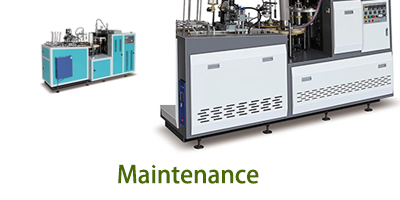The proper maintenance of the paper bowl machine plays a crucial role in its stable operation, extending service life and ensuring the quality of paper bowl production. Correct and regular maintenance not only reduces the probability of machine failures and improves production efficiency but also saves repair costs and time for enterprises. The following will introduce in detail the key points and methods of maintaining the paper bowl machine.
I. Daily Cleaning
1. External Cleaning
After each day's work, wipe the exterior of the paper bowl machine with a clean, soft cloth. Remove dust, paper scraps, and other debris from the surface to prevent them from entering the machine and affecting its performance.
For stains on the machine's exterior, gently wipe them with a mild cleaner (such as diluted dishwashing liquid) and a damp cloth. Avoid using cleaners containing corrosive ingredients to prevent damage to the machine's surface coating.
2. Internal Cleaning
Regularly (it is recommended to do this once a week) clean the paper scraps and dust inside the machine. First, turn off the power of the machine, open the protective cover or side panel of the machine, and carefully clean the debris around the feeding mechanism, forming molds, cutting tools, and other components using a small vacuum cleaner or a soft brush.
When cleaning the forming molds, pay special attention to the gaps and recesses of the molds, as these places are prone to accumulate paper scraps. You can use a toothpick or a small tool to assist with the cleaning, but be careful not to damage the molds.
II. Lubrication Maintenance
1. Identifying Lubrication Points
Familiarize yourself with the mechanical structure of the paper bowl machine and identify all the moving parts that require lubrication, such as gears, chains, shafts, and bearings. These parts rub against each other during the machine's operation, and proper lubrication can reduce wear and tear and extend their service life.
2. Selecting Appropriate Lubricants
Select suitable lubricants according to the requirements of the machine's manual. Generally, for high-speed rotating parts such as motor bearings, high-temperature grease can be used; for ordinary gears and chains, general-purpose mechanical lubricating oil can be used.
3. Regular Lubrication
Lubricate according to a fixed cycle (such as every 100 hours of operation or as recommended in the machine's manual). Use a clean oil gun or oil brush to evenly apply the lubricant to the lubrication points. When applying lubricating oil, pay attention to the appropriate amount to avoid excessive dripping of the lubricant onto other parts of the machine or onto the products.
III. Component Inspection and Tightening
1. Regular Component Inspection
Regularly (once a month) inspect the key components of the paper bowl machine, including motors, sensors, controllers, heating elements, etc. Check whether the motor has abnormal noises or vibrations, whether the sensors are sensitive and accurate, and whether the display screen and buttons of the controller work normally.
For heating elements, check whether they can heat up normally and whether the temperature is within the set range. You can use a thermometer or other tools for detection.
2. Tightening Loose Components
During the inspection process, pay attention to whether the screws, nuts, and other connecting parts on the machine are loose. Use appropriate tools (such as wrenches, screwdrivers) to tighten the loose parts. Pay special attention to whether the connections of the parts that often vibrate (such as the motor base) are firm.
IV. Mold Maintenance
1. Mold Cleaning and Inspection
After each use, clean the surface of the molds to remove paper scraps and oil stains. You can use special mold cleaners and soft cloths for cleaning.
Regularly inspect the wear and tear of the molds. Check whether there is any scratching, deformation, or damage on the forming surface of the molds. If the molds are found to be severely worn, which will affect the forming quality of the paper bowls, they should be replaced or repaired in a timely manner.
2. Mold Storage
When the machine is not used for a long time, store the molds properly. After cleaning and drying the molds, apply a thin layer of anti-rust oil, and then place them in a dry and ventilated place to avoid rusting and deformation of the molds.
V. Electrical System Maintenance
1. Electrical Component Inspection
Regularly inspect the wires, plugs, sockets, relays, and other elements in the electrical system. Check whether the wires have any damage or aging, whether the plugs and sockets are in good contact, and whether the relays work normally.
For the parts with circuit boards, check whether there is any dust accumulation or component damage on the circuit boards. If the circuit boards are found to be problematic, contact professional maintenance personnel in a timely manner for repair.
2. Grounding Inspection
Ensure that the grounding of the paper bowl machine is good. Regularly check whether the grounding line is connected firmly and whether the grounding resistance meets the safety standards. Good grounding can prevent electrical faults and electric shock accidents.


 Nov 17,2024
Nov 17,2024








